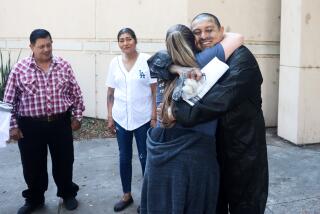DNA could speak for a long-dead, long-unknown L.A. baby
And here, sorrowfully, she is again. Another dead child, her name unknown for almost three decades.
Now that New York’s cold case of another long-dead, long-unknown child has been solved, Los Angeles is hoping that its anonymous little girl, Baby Jane Doe #61, found dead in 1985, might also be matched with a name, and even a family — and one day, maybe linked to whoever neglected her to death.
New York’s “Baby Hope” was 4 years old in 1991 when she was sexually assaulted and killed. Her body was found in a plastic cooler alongside a Manhattan highway. Her tombstone was chiseled not with a name but with the hot-line number to report who she was.
There’s new hope for such old cases, thanks to DNA. Yet as a private group, the National Center for Missing and Exploited Children can only compare the L.A. Baby Doe’s DNA to the database of DNA that people have voluntarily submitted in hopes of finding a lost child.
It’s possible that the child’s DNA profile might be able to be cross-checked against the federal National Missing and Unidentified Persons System, www.namus.gov, and the coroner would likely have shared it with California’s DNA database called CODIS — actually multiple databases, maintained by the FBI.
As LAPD Det. Marie Grebinski told me: “Some DNA databases just store profiles; other databases are constantly being examined for matches. An example would be an unknown DNA profile found at a murder scene. It would be compared with databases that receive new profiles from recently arrested individuals. The unknown profile would constantly be compared to new samples until a match occurred, thereby constituting a hit.”
But “if this child’s DNA was uploaded, it will not be compared to anyone until a relative steps forward to see if he or she is a match.” Current standards “require two familial samples to confirm identification. The Jane Doe in this case does not actively have her profile compared with others to scan for relatives. It works the other way, where a relative has to look for her.”
So much going against her in life, and in death.
In New York, it was a tip, and then the DNA from the lick of an envelope, that led to the child’s identity, an arrest — her cousin — a confession, and at last a tombstone with her real name on it, Anjelica Castillo.
No one reported L.A.’s dead girl missing at the time; the likelihood that someone is still looking for her nearly 30 years later is even dimmer, especially given how she died.
L.A.’s Baby Doe would have been in her late 20s had she lived. She was perhaps 10 months old, but weighed about what a child half her age should weigh when her body was found lying on its side in an oil-soaked alley behind a Baldwin Hills apartment building in August 1985.
She was naked — not so much as a diaper on her, or a pair of shoes, although she would likely have been too weak and sickly to be able to walk anyway.
She died of pneumonia brought on by malnutrition, which is why the LAPD then listed her death as a homicide. Grebinski told me that while there was no evidence of sexual abuse, this child, not yet a year old, had a long history of physical abuse, with scars and healed broken bones.
You can’t see it in the composite the National Center for Missing and Exploited Children has posted of her, but she had four teeth.
The two front ones were so large for so small a girl that when she smiled, you would have been startled by that grin, “a little baby with big teeth in her mouth,” said Angela Williamson. She is the manager of the unknown victim program for the center, which began a new push on these old cases a couple of years ago. It carries about 650 children on its books, up to age 17, and about 100 of those are in the age range of L.A.’s unknown little girl.
If anyone’s ever been looking for this girl, there’s no record of it.
It puzzled me then and it puzzles me now. Did no one notice a child suddenly missing? What kind of life does anyone lead where a little girl can just vanish and no one can ask what’s become of her? “Was there something,” Williamson wondered, “that changed in her family situation that they couldn’t care for her anymore?”
Someone had already taken the trouble to pierce her ears, and someone had evidently taken the trouble to undress her.
This child’s body was cremated. In 1985, the LAPD told me it got “not one call, not even from a kook,” about who she was. Lt. Vance Proctor, then the head of the child protection unit, said he had never had a case of a little child turning up dead and not a peep being heard from anyone about her.
One woman who did call, a lot, to try to find out what happened is Alice Beard. She’s just about to retire from her L.A. County social worker job, but in 1985, she organized a memorial service for the baby and raised $380 toward a reward (the city never got a nibble on its $5,000 reward). She later called and emailed me often to let me know how much this haunted her, and that she was still trying to find out what had happened to this baby.
There’s an LAPD tip line for this cold case that’s being heated up again: 1-877-LAPD 24-7 (1-877-527-3247).
She could still have a name, could still have justice.
It took almost 50 years to figure out who Little Miss 1565 was, but it finally happened. She was an 8-year-old girl found dead and unclaimed after a devastating 1944 Connecticut circus fire that killed 168 people. Hartford police put flowers on her grave every year, and a determined firefighter eventually learned not only her name — Eleanor Cook — but discovered that she too was a crime victim, of a fire that was not an accident but arson.
Revisiting this story for some reason made me think of the Black Dahlia. She, like the baby, is dead. She and the baby were both killed, although in exceptionally different ways. But everyone — even people who weren’t born in 1947 — knows about the Black Dahlia. No one seems to know this child, and whoever does isn’t talking. So it will be left for this little girl, through the biological samples of her that remain, to speak for herself, even speak her name.
ALSO:
Carol Schatz, a force for downtown L.A.
‘Saturday Night Live’ on its diversity problem: arrogant and not funny
Follow Patt Morrison on Twitter @pattmlatimes
More to Read
A cure for the common opinion
Get thought-provoking perspectives with our weekly newsletter.
You may occasionally receive promotional content from the Los Angeles Times.











